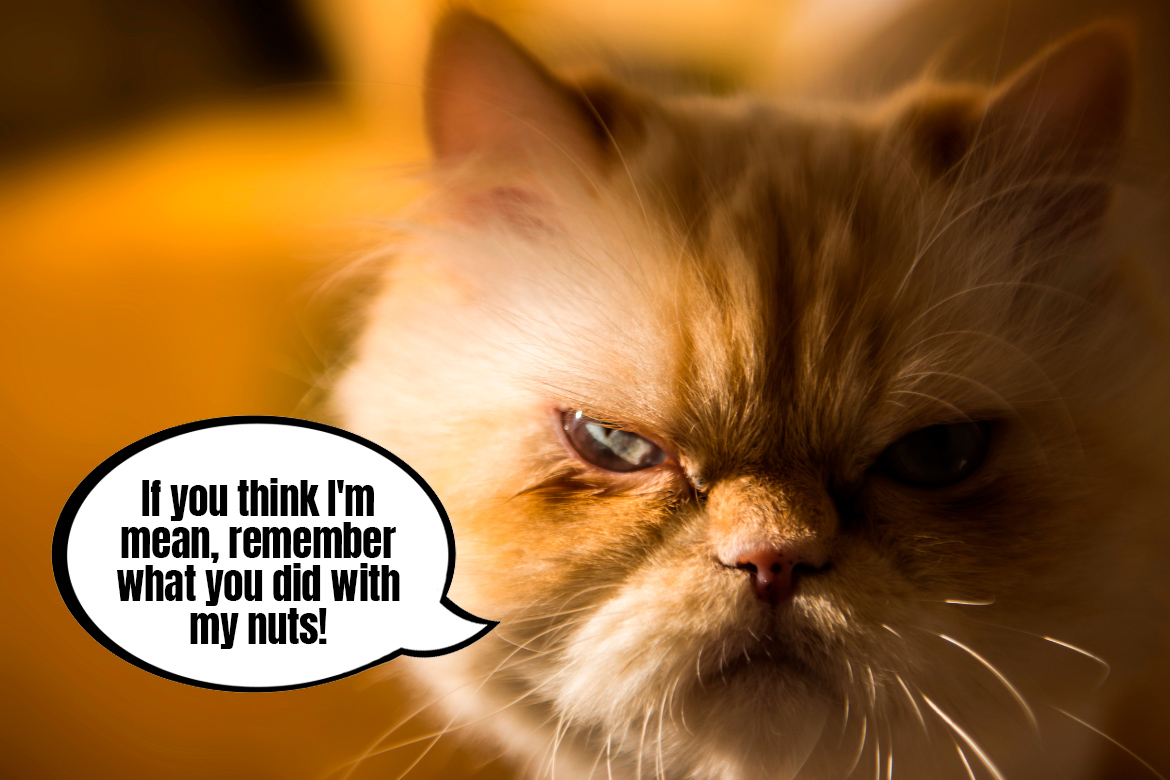Can a cat be “mean”? If we were to open a book of myths, superstitions and old wives’ tales about cats, “meanness” would certainly be at a top spot there – how many times have we heard that cats are unfriendly, despicable and always ready to do us dirty? As cat Carers we know, of course, that people who created those myths couldn’t be more far from the truth and know nothing about cats who are lovely, intelligent and, above all, always acting like the nature is telling them to. It’s just us, hoomans, who don’t always understand them. Today, fabCats, we take it upon ourselves to debunk the “mean cat” myths. Will you help us?
Being mean is a human thing… but not a cat thing!
Observing how our cats act, it’s easy to associate some of their behavior with our own acts, qualities and emotions. They lost their favorite toy? Kitty is definitely sad now. A fly run away from under the paw? They must be angry about it. Went on top of a shelf and dropped our holiday souvenir to draw our attention? It’s so mean! To nobody’s surprise, this couldn’t be further from the truth.
Meanness, just like most other emotions described above is an attribute that’s typical for people and though some cat reactions and actions could resemble our own, their scale of emotions and reactions is completely different. This effect is known as antropomorfizm – giving animals (and things) nazywamy antropomorfizacją – nadajemy zwierzętom (bądź też rzeczom) human qualities so they’re easier for us to understand. And cats, being cats, are not an open book that’s easy to read. Their language, ways of communication and behavior are different from ours and to understand them, we have to learn to read them instead of trying to interpret them as if cats were people.
The world from a cat’s perspective
Cats don’t have the ability to interpret their own actions as good or bad – the way they see the world and everything they do on a daily basis is a result of associating certain behavior with our previous reaction to it. And since the cat doesn’t know that a certain behavior can be taken as good or bad, they don’t feel remorse or responsible for our reactions. They also aren’t able to act meanly since they can’t connect the dots and see that our negative reaction to what they did could “teach us a lesson”.
Cats learn repetitive actions and remember the reaction they caused before. If we start shouting at the cat and shoo them away for what they did, cats won’t connect the consequences with their actions – they will only know that we’re the source of noise and they we should be feared of. They will also notice that their action caused some sort of reaction and since it did (and they wanted to get our attention), it’s still a success.
Read more about unwanted cat behavior and how to stop it on our blog: https://blog.mykotty.pl/en/2022/08/08/how-to-train-a-cat-to-stop-their-unwanted-behavior-lets-work-on-cat-habits/
Myths about the supposed “feline meanness” – let’s debunk them all!
Those who say cats can be “mean and malicious” often say that they don’t have feelings, are cold and only care for themselves – the typical individualists. But there’s not even a grain of truth to it! Cats, of course, can’t have compassion, but they can read our emotions and react accordingly. They’re not “grateful”, but will show sympathy and love for us, giving them a sense of security, happiness and love. And they’re absolutely not “mean and malicious”, though they can act in a way that’s not acceptable for us – just like some people around us do. Cats feel just like hoomans do, though their emotions and actions should be interpreted differently – they’re not small people, but our animal friends with their own language, communication system and their own set of emotions.
So what can you do the next time your cat acts in a way that a person who doesn’t like cats could say they were being “mean”? Figure out what could be the cause of your cat’s actions, what they want to tell you with it and try to react in a way that doesn’t promote the unwanted behavior. For example, our team cat Teddy peed on our bed one time and we didn’t understand what was wrong. It turned out he had some behavioral issues which we worked through with a specialist and since then, our bed has stayed dry and our cat is happy. Another example is our friend’s story. He lives with his partner’s cat and told us that the cat always sleeps on his side of the bed – he took it as the cat being “mean”. We suggested, however, that maybe it’s the cat’s way of getting his attention in an attempt to become friends. Our buddy said he never considered that possibility and will rethink his attitude towards the cat, which made us really happy 🙂 It shows that even people who do think stereotypically about cats can change their attitude if we explain everything to them calmly, showing a different point of view. The cat Carer diplomacy skills carry the power here, fabCats!
Cat goes potty outside the litter box “to be mean” – MYTH. Cats can tell us they’re not feeling well. They won’t say they’re hurt, have bladder issues, or that every visit to the litter box is causing them pain and they don’t know what to do. What can they do? They can go potty outside the litter box just to not feel the same pain as they did previously. And they’re not doing it intentionally to get our attention – we, as their Carers, should notice worrying symptoms and look for their causes.
The cat “maliciously” knocks things off the shelves – MYTH. It’s not meanness, but most often boredom or lack of appropriate resources that cause such destructive behaviors. If we don’t provide our cats with regular, engaging playtime, they will find a way to get some fun on their own. And as it turns out, things falling off the shelves are quite interesting – something was up there on the shelf, but once touched with a paw, it fell down? Now we have to jump down and check what happened to it! Remember, fabCat, that if your reaction to things being knocked off the shelves is putting them right back, you’re in trouble – the cat will realise that the item goes back to its place right after it fell and immediately jump up there just to knock it down once more. Now that’s fun!
Cat “intentionally” destroys my furniture – MYTH. While knocking things off the shelves may be about getting the Carer’s attention and engaging them in some playtime, scratching is never a matter of attention. Scratching is one of the primary elements of a cat life – a self-care ritual that both domestic and wild cats spend a lot of time on. Furniture is just the first thing that happens to be under cats’ paws when there’s no scratchers in sight, which is why at myKotty we always say how important it is to furnish a cat’s house with a scratcher (or multiple of them, as our 9-year experience shows). Your sofa will be grateful for that 🙂
Cat “purposefully” makes vet visits difficult – MYTH. Nobody likes going to the doctors’ and cats are able to remember that somebody previously pricked them with a needle while drawing blood, someone else stuck a thermometer into their butt and the whole situation was preceded with sitting in a waiting room, with dogs looking into the carrier. Every visit like this is a huge stress for cats so there’s no surprise that, based on their previous experiences, they do anything to not get into the carrier. It’s not their “meanness” – it’s just a fear of repeating the past. A solution? Work on positive reinforcement with your cat and carrier, as well as with the vet visit itself. Staying calm, having positive attitude and carrying snacks can solve many issues. We always cover the entire carrier with a breathable material (a thin cotton sheet) so that the cat doesn’t stress out seeing their surroundings. The less they see, the better 🙂
Night meowing as a “punishment” for a mid-day wake up – MYTH. Yes, cats can sleep through 80% of their day and don’t like being woken up. It doesn’t mean, however, that the songs they sing us at 4 a.m. is their revenge for that. If your cat likes to test their opera talents in the middle of the night, most of the times they just have too much energy, are hungry or something’s wrong. Remember that cats are active at dusk and dawn – for them, 4 a.m. is the best time to wake up 🙂 What to do to stop it? Play with the cat before you go to bed and right after you wake up – work on your routine and, with time, you’ll leave sleepless nights behind you.
Conclusion
Cats are never “malicious” – their life is a constant action-reaction sequence, drawing on their previous experiences. Sometimes though, as emotions come in, we can’t resist but to take some cat behaviors negatively and hey – we learn our whole lives and cat communication is definitely the area we, cat Carers, can (and should) work on.
Which stereotypically “mean” cat behaviors have you heard of, fabCats? Or maybe you managed to convince a person who was spreading those types of myths that they’re actually not right? We’ll gladly debunk more myths for you so send us them in the comments.




